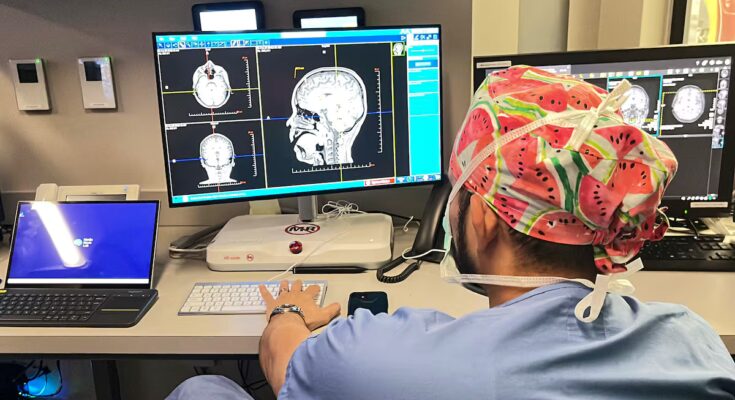A controversial medical procedure has put Spanish neurologists on alert: a minimally invasive surgery, performed by plastic surgeons, that promises to cure migraines. In Spain it is a niche practice, offered only by a few private clinics, but neurologists have raised the alarm after detecting a proliferation of these procedures. They warn that there is not enough scientific evidence – or even a biological explanation to justify it – and urge patients not to undergo these surgeries.
This controversial procedure, more common in the United States, is a minimally invasive surgical technique that involves decompression of extracranial nerves: surgeons identify areas of pain – trigger points – and release nerves they believe are compressed there. American plastic surgeons defend the effectiveness of this approach, but Spanish neurologists warn that the studies supporting this technique are of low quality, with few patients, very heterogeneous diagnoses (not everyone suffers from migraines) and also diversified surgical procedures.
Its proponents – particularly those in the field of plastic surgery – argue that, in selected patients, this strategy can be effective in reducing symptoms and say they have conducted studies to prove it. However, in Spain, those who support this technique are few and far between. Anesthesiologists, the other medical specialty closely related to migraines and who typically lead pain management units, also do not recommend it. Migraines affect 12% of the Spanish population, although neurologists estimate that more than 40% go undiagnosed and do not receive adequate treatment.
This controversial migraine surgery had its origins serendipitously, in a chance discovery by surgeon Bahman Guyuron earlier this century, when some of the patients on whom he had performed a forehead lift told him that, after the plastic surgery, they stopped suffering from migraines. From this, Guyuron theorized that migraines occur when the peripheral branches of the trigeminal nerve become irritated and release neurotoxins, and he adapted forehead elevation to nerve decompression surgery.
No biological justification
“It is scandalous that this technique is allowed without evidence,” says Robert Belvís, coordinator of the Headache Study Group of the Spanish Society of Neurology (SEN). The doctor claims that migraine surgery “lacks biological plausibility”, meaning that there is no pathophysiological explanation to justify the surgery: “Migraine is a brain disease; decompression of the nerves makes no sense. No damage to the nerves has been observed. They have not proven that these compressions exist.”
The neurologist also points out that international guidelines for the treatment of migraine – which reflect the scientific consensus for addressing this condition – do not even mention these surgical techniques.
The American Society of Plastic Surgeons, however, includes it in its clinical practice. Applicants are stated to be individuals diagnosed with migraine or occipital neuralgia who have unsuccessfully tried other treatment approaches, are in good physical health, and have realistic expectations. According to this scientific society, the price of these procedures varies from 5,000 to 15,000 dollars. And the effectiveness, as we read on its website, is high: “Studies have shown that between 70% and 95% of patients who undergo surgery experience an improvement or complete elimination of migraines,” the company says.
To express its opinion, the Spanish Society of Plastic, Reconstructive and Aesthetic Surgery refers to Ahmad Saad, American plastic surgeon and member of the board of directors of the International Society of Aesthetic Plastic Surgery. The doctor, who also practices in a clinic in Barcelona, is an expert in migraine surgery and defends its validity: “It is not a treatment for everyone, you have to choose the right patient. The trials are of good quality and the experience with thousands of patients is there.”
When asked about the neurologists’ position, Saad underlines: “The evidence is there, but I don’t know if they just don’t want to see it or accept it. When the pioneers of this technique started performing it in the United States, they were at odds with the neurologists, but today it is the standard of care. In Spain it is not like that: you have the whole neurological community against you.” Regarding the limited diffusion of this technique in Spain, the American doctor states that “it’s not that there are no surgeons to perform it, the problem is that there are not enough patients”: “Patients with migraine are referred to neurologists. If these doctors don’t believe in migraine surgery, you won’t have patients.”
Belvís claims that this technique has not gone through the animal testing phase and questions the research methods followed before transferring it into conventional clinical practice.
Questionable scientific evidence
As for the available scientific evidence, Saad shares about 30 studies – mostly conducted by Guyuron and his team – that indicate the feasibility of these techniques, including some clinical trials. But Belvís emphasizes: “It’s not a question of quantity, but of quality,” he says, pointing out that the available studies are conducted with a limited number of patients and with different surgical approaches. He also points out that neurologists are rarely among the researchers who author the studies and that they are usually published primarily in plastic surgery journals. “All drugs, before they reach the market, have three studies with more than 1,200 patients. The three studies for this surgery recruited fewer than 200 people.”
A review of 600 treated patients published in Frontiers in Neurology downplayed the effectiveness of the surgery, concluding that it eliminated migraines in 38% of patients with this diagnosis included in their analysis. However, the review emphasizes: “More elaborate randomized trials with transparent reporting on patient selection, drug use and surgical procedures, and with detailed and longer follow-up times are needed.”
Agustín Mendiola de la Osa, vice president of the Acute and Chronic Pain section of the Spanish Society of Anesthesiology, Resuscitation and Pain Therapy (SEDAR), echoes Belvís’ sentiments: “We do not have good results with migraine surgery. What we have seen in some treated patients is that, at the beginning, they seem to be fine, but then it is no longer the case. It seems more like a case of wanting to but not being able to, they want to get better, but reality takes over. we recommend surgery for migraines because there is no medical explanation to justify it.
“Legally questionable”
In its statement, the Spanish Society of Neurology says that the aim of its warning is not only to address patients and doctors, but also the directors of Spanish clinics, public and private, “which allow surgical interventions without scientific evidence to be performed as standard healthcare services”. “We believe that, moreover, it is also questionable from a legal point of view,” they say, although they have not yet filed any official complaint with the health authorities.
Contacted by this newspaper, the Spanish Ministry of Health said it had not received any formal complaint on the matter, but a spokesperson noted: “Health centers (public or private) have the responsibility to ensure that the procedures they offer are safe, ethical and based on scientific evidence and must have regional health authorization. If they offer techniques without scientific support, they may incur administrative or professional liability.” The spokesperson also underlined that “any new technique, procedure or health technology may be subjected to evaluation by the Spanish Network of Health Technology Assessment Agencies (RedETS)”, a body coordinated by the Ministry of Health. Its reports serve as a basis, for example, for including or excluding a technique from the National Health System. However, no organization has specifically requested that RedETS evaluate migraine surgery.
Sign up to our weekly newsletter to get more English-language news coverage from EL PAÍS USA Edition



